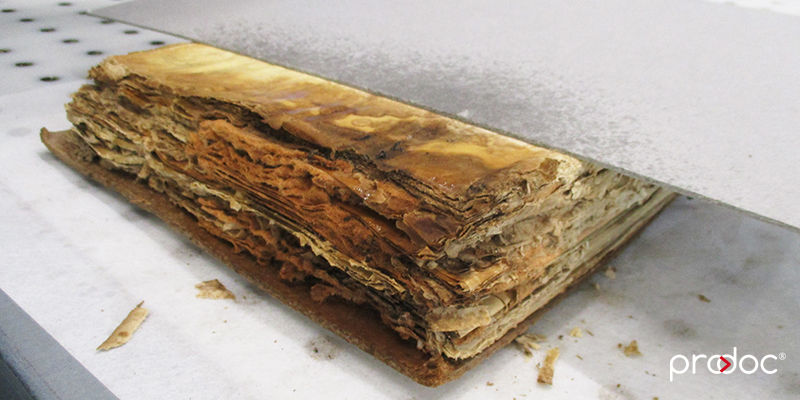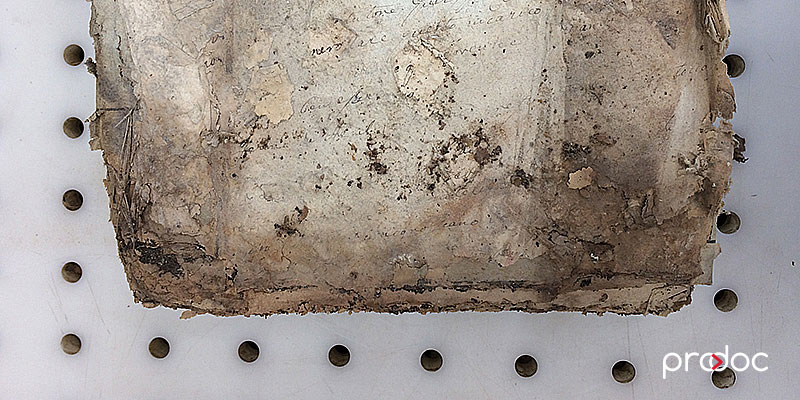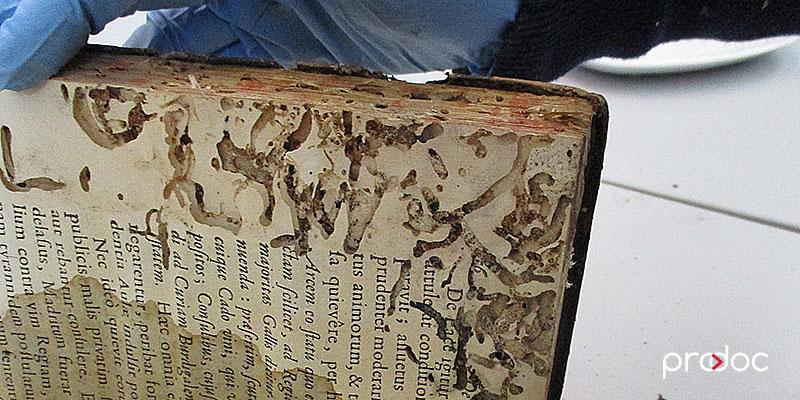Biological degradation is mainly determined by the microbiological attack of fungi, bacteria, molds, and by the infestation of insects and rodents inside the storage rooms and the material itself, and is triggered by certain favorable environmental conditions.
Fungal spores and molds are tiny volatile particles constantly present in any existing environment, but their settlement depends mainly on particularly high relative humidity and temperature values and on insufficient ventilation of the storage rooms: in these conditions, in fact, the particles are deposited on the material causing the birth and growth of molds and fungi that cause substantial damage to books and documents.
In this article we will talk about:

Damage caused by molds and fungi
Fungi are directly responsible for an accelerated decomposition process of cellulose and damage to glues and adhesives; their action is extremely slow and is often noticeable only when it causes damage of a considerable entity.
In the same way, molds attack cellulose fibers and inks causing structural damage to the substrate and a modification of the pigmentation, usually known as foxing.
In general, damage due to the action of microorganisms can be classified into three categories:
- chromatic alterations;
- structural alterations of the basic component of the materials;
- alterations of essential additive components.
All these processes are extremely slow and gradual and, for this reason, every slightest presence of microorganisms must be a cause for concern and must be the engine for starting a series of safeguard practices aimed at disinfecting the affected material and preventing damage to material not directly affected.
As a rule, in fact, when damage due to the action of microorganisms on archival material is detectable with the naked eye, it is a symptom of an extremely advanced stage of deterioration.

Damage caused by insects
Deterioration due to the action of insects on the book material can cause both mechanical and chemical damage, depending on the species and extent of the infestation.
There are four main categories of insects that are involved in the deterioration of books and documents, and they are divided according to the interaction they have with the material itself.
Insects that feed on books
The first group is made up of all the species of insects that feed on the substances that make up the documents, in particular paper, leather, parchment and wood; the most common insect families belonging to this group are cockroaches, lepismatidae, which includes the very common silverfish, and termites, and the type of damage they cause is mainly due to superficial erosions and spots of dark color due to the deposit of excrement.
Termites, if left free to act on the library material, can cause enormous damage due to their habit of digging crater-shaped chasms that can also affect the entire surface of a volume.
Insects that feed on molds that settle on books
The second group is formed by insects that feed on the molds that attack the book material; the damage they cause tends to be minor and are due to minute surface erosions of papers and adhesives, but their presence can be harmful to men, to whom they can cause allergic reactions or dermatitis, requiring the control processes necessary to guarantee the safety of all those who may come into contact with the infested volumes.
Insects that lead the entire life cycle inside books
The third group of insects is characterized by those species that carry out the entire life cycle within the materials they feed on: for this reason, their presence is often noticed only when they make small holes on the surface. to proceed with the flickering and to conclude its life cycle outside the material.
The main damage caused by this family of insects is due to the creation of deep galleries, inside books and volumes, which spread from the center towards the edges.
Insects that feed on wood
The fourth and last group of insects that is involved in the deterioration of archival and documentary material is composed of xylophagous insects that complete their entire life cycle inside the wood: the damage they cause is therefore due to either the attack of boards in wood placed to close some types of documents, or to damage to the shelves, which can even cause collapses and falls of the material stored there.

Damage caused by rodents
Another biological deterioration agent that can cause significant damage to the documentary material is represented by the presence of rodents inside the storage rooms: they can cause damage to books and volumes, to the furnishings of the premises and to the electrical systems caused by constant gnawing and from the deposit of excrement.
The risk of rodent invasion must also be carefully considered because it can be a vehicle for very serious infectious diseases and infesting insects, such as fleas and lice, which can be extremely harmful, not only for the heritage to be protected, but also for the men who comes into contact with them.





